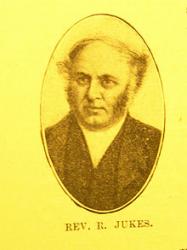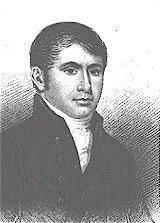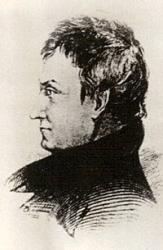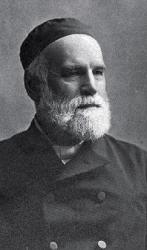Planning worship?
Check out our sister site, ZeteoSearch.org,
for 20+ additional resources related to your search.
- |
User Links
Person Results
‹ Return to hymnal






Export as CSV
Richard Jukes

1804 - 1867 Hymnal Number: 75 Author of "Mercy's free, mercy's free" in The Revivalist Rv Richard Jukes United Kingdom 1804-1867. Born at Clungunford, Shropshire, England, his father a stone mason, he was a prankster when young. He followed his father’s trade and became a stone mason for awhile before becoming an itinerant preacher. In 1829 he was part of a team missioning in Wiltshire and Aldbourne. His preaching was sometimes disturbed by efforts to disband the crowd, he even at times had eggs thrown at him. However, a society was formed and a barn was obtained for a place of worship. He was known as “the bard of the poor”. Over time he became a popular Primitive Methodist minister and hymn writer. He married Phoebe Pardoe (1805-1826) in 1825, but she died of typhus after less than a year of marriage. Later, after her death, he married Charlotte Smith (1806-1873), and they had eight children: Mariam, Charlotte, Thomas, Joshua, Amelia, Rowland, Richmond, and Martha. He ministered from 1827 to 1859 at 17 different circuits.. He ministry was widely appreciated. It is noteworthy that several of his appointments were to significant circuits of that time: Tunstall, Staffordshire, Ramsor, and Darlaston in the Black Country, where he spent a large part of his active ministry, retiring there. One trait he had was when writing hymn lyrics, he would try to pair them with popular tunes of the day and sing them in the streets so others would do the same.. and many did. He died at West Bromwich, England.
John Perry
Richard Jukes
William Bengo Collyer

1782 - 1854 Hymnal Number: 262 Author of "O you must be a lover of the Lord" in The Revivalist William Bengo Collyer was born at Blackheath Hill, in 1782, and studied at Homerton College. Before completing his twentieth year he became pastor of a Congregational society at Peckham, continuing in that position through his life. He died in 1854. He received the degree of D.D. from the University of Edinburgh in 1808. For many years he was one of the most popular Dissenting ministers in London. He published many hymns and some works on theology.
--Annotations of the Hymnal, Charles Hutchins, M.A. 1872.
===================
Collyer, William Bengo, D.D., born at Blackheath, April 14, 1782, educated at Homerton College, where, when 16 years old, he was enrolled as a student for the ministry. At 20 he began his ministry at Peckham on Dec. 17, 1801 ordained pastor of a small church consisting of ten communicants. From 1814 to 1826 he was also pastor of a Church meeting in Salters' Hall. On June 17, 1817, a new chapel was opened for him at Peckham. There, from the time of his settlement in 1801, he laboured with great success and honour until Dec. 11, 1853, on which clay he preached for the last time. He died Jan. 8, 1854.
Dr. Collyer was eminent in his day as an eloquent Evangelical preacher, when formalism in worship, and Arianism in doctrine, prevailed. He was a man of amiable disposition, polished manners, and Christian courtesy; popular with rich and poor alike. He was the author of a series of lectures on Divine Revelation, in seven volumes: Scripture Facts, Prophecies, Miracles, Parables, Doctrines, Duties, Comparisons. Dr. Collyer compiled a hymn-book with the title, Hymns partly collected and partly original, designed as a supplement to Dr. Watts's Psalms and Hymns, 1812. It was intended at first for the use of his own congregation only, and was to include many hymns composed by himself, to be sung after sermons which he had preached to them, but he was led to alter the plan. It comprises 979 hymns, 6 choruses, and 4 doxologics, arranged in groups according to their authors, and not subjects. Of this number 57 were written by Dr. Collyer, and are for the most part short descriptive or didactic poems, religious or moral essays in verse, and not hymns addressed to the Creator and Redeemer. Some of them are devoid of Christian truth, and are poems of nature or of sentiment. Some of them were written during the hard and sorrowful times of the wars of Bonaparte, and relate to famine and national calamity. Several were prepared for the public meetings of missionary and benevolent societies, which had their origin in his time. He also published Services suited to the Solemnization of Matrimony, Baptism, &c, 1837, which contained 89 of his hymns, &c.; Hymns for Israel, a Tribute of Love for God's Ancient People, 1848 (41 hymns). In Dr. Leifchild's Original Hymns, 1843, there are also 39 of his compositions. Many of his pieces appeared in the Evangelical Magazine, and were also appended to his numerous published Sermons. A few of his hymns are still in common use, including. "Another fleeting day is gone"; "Assembled at Thy great command"; "O Jesu, in this solemn hour"; "O Thou, the helpless orphan's hope"; "Return, O wanderer, return," and the fine cento, "Great God, what do I see and hear."
[Rev. F. J. Faulding, D.D.]
--John Julian, Dictionary of Hymnology (1907)
======================
Collyer, William Bengo, p. 243, ii. The following hymns by Dr. Collyer are also in common use:—
1. Another fleeting day is gone. Evening. (1812.)
2. 0 Jesus, in this solemn hour. Reception of Church Officers. (1842.)
3. O Thou, the helpless orphan's hope. On Behalf of Orphans. In the Evangelical Magazine, 1808, p. 48.
4. See the clouds upon the mountain. Sunday Morning. (1842.)
5. Soft be the gently breathing notes. Praise to the Redeemer. (1812.)
6. Softly the shade of evening falls. Evening. (1812.) From this, “Soon shall a darker night descend" is taken.
7. Thou Prince of glory slain for me. Good Friday. (1812.)
The date 1812 is that of his Collection, and 1842 of Leifchild's Original Hymns.
--John Julian, Dictionary of Hymnology, Appendix, Part II (1907)
William Bengo Collyer
George Heath
1745 - 1822 Hymnal Number: 214 Author of "My soul be on thy [your] guard" in The Revivalist Rv George Heath DD United Kingdom 1745-1822. Born at Exeter, Devon, England, he was educated at the Dissenting Academy and King’s College, Cambridge. He married Mary Ann Kean, and they had 4 children: Louisa, John, Charles, and Benjamin (also a minister). He served as pastor of the Honiton, Devonshire, Presbyterian Church, but proved unworthy and was dismissed for cause. He later became a Unitarian minister. In 1781 he published “Hymns & poetic essays sacred to the worship of the Deity”. He also authored a “History of Bristol”. He became Headmaster of Eton College (1792-1802). He joined the Anglican Church and became Canon of Windsor (1800-1822), Rector of Monks Risborough, Vicar of Sturminster Marshall, Dorset, Vicar of Piddletown, Vicar of East Beachsworth (1805-1814), and Fellow of the Royal Society (1795-1822). He was appointed to the 4th stall in St. George’s Chapel in 1800, Windsor Castle, and died at his residence in the Cloisters, Windsor Castle.
John Perry
=======================
Heath, George, became pastor of a Presbyterian Church at Honiton, Devon, in 1770, and died in 1822. He published a History of Bristol, 1797. Also Hymns and Poetic Essays Sacred to the Public and Private Worship of the Deity, &c, Bristol, 1781, from which "My soul, be on thy guard" (Steadfastness), is taken.
--John Julian, Dictionary of Hymnology, Appendix, Part II (1907)
George Heath
Andrew Young
1807 - 1889 Hymnal Number: 394 Author of "There is a happy land, Far, [not] far away" in The Revivalist Young, Andrew, second son of David Young, for more than fifty years a most efficient teacher in Edinburgh, was born at Edinburgh, April 23, 1807. After passing through a distinguished eight years' literary and theological course at the University of Edinburgh, he was appointed in 1830, by the Town Council, Head Master of Niddry Street School, Edinburgh, where he began with 80 pupils, and left with the total at 600. In 1840 he became Head English Master of Madras College, St. Andrews, where he was equally successful. He retired from St. Andrews in 1853, and lived in Edinburgh, where he was for some time the Superintendent of the Greenside Parish Sabbath School He died Nov. 30, 1889; Many of Mr Young's hymns and poems were contributed to periodicals. A collected edition of these was published in 1876, as The Scottish Highlands and Other Poems. His poems entitle him to rank in the first order of Scottish minor poets. Some of his hymns are very sweet. His "There is a happy land" (q. v.) has attained great popularity. [Rev. James Mearns, M.A.]
--John Julian, Dictionary of Hymnology (1907)
Andrew Young
Marianne Nunn
1778 - 1847 Hymnal Number: 410 Author of "O how he loves" in The Revivalist Marianne Nunn United Kingdom 1778-1847. Born at Colchester, Essex, England, she lived a life of relative seclusion. She authored a few hymns and was interested in mission work. Her brother, John, a minister, published a song book “Psalms and hymns”,(containing her hymn noted below), eventually circulated. She also published a book, “The benevolent merchant”. In 1830 Joshua Leavitt included her hymn in his song book, “The Christian lyre”, which was later in America. She died unmarried.
John Perry
=========
Nunn, Marianne, was born May 17, 1778, and died unmarried, in 1847. She published The Benevolent Merchant, and wrote a few hymns, including the following:—
One there is above all others, O how He loves. [The love of Jesus.] This was written to adapt John Newton's hymn “One there is above all others, Well deserves the name of friend," to the Welsh air, Ar hy-d y nos, and consisted of one stanza of 5 lines, with the refrain "Oh how He loves!" at the end of lines 1, 2 and 5, and the remaining 3 stanzas in 5 lines without the refrain, it being understood that the refrain was to be repeated. (Original text in Lyra Britanica, 1867, p. 449.) It was first published in her brother's, the Rev. John Munn's Psalms & Hymns, 1817. It has undergone several changes at various hands. In Curwen's The New Child's Own Hymn Book, 1874, it begins, "There's a Friend above all others," which is adopted from the American collections. It also sometimes begins, "One is kind above all others." In addition, where the original first line is given the rest of the hymn is considerably altered. Its use as a hymn for children is very extensive.
--John Julian, Dictionary of Hymnology (1907)
Marianne Nunn
Bernard Barton

1784 - 1849 Hymnal Number: 275 Author of "At evening it shall be light" in The Revivalist Barton, Bernard, commonly known as the "Quaker Poet," was born in London Jan. 31, 1784, and educated at a Quaker school at Ipswich. In 1798 he was apprenticed to Mr. S. Jesup, a shopkeeper at Halstead, Essex, with whom he remained until 1806, when he removed to Woodbridge, Suffolk, and entered into business with his brother, as a coal and corn merchant. On the death of his wife at the end of the first year of their married life, he proceeded to Liverpool, where he acted as a private tutor for a short time. He returned to Woodbridge in 1810, where he secured an engagement in the local bank of the Messrs. Alexander. This appointment he held for 40 years. He died at Woodbridge, Feb. 19, 1849. During the same year his daughter published his Poems and Letters, with a Memoir. His poetical works were numerous, including:—
(1) Metrical Effusions , 1812; (2) Poems by an Amateur, 1818; (3) Poems , 1820; (4) Napoleon, and other Poems, 1822; (5) Poetic Vigils, 1824; (6) Devotional Verses founded on Select Texts of Scripture, 1826; (7) A Widow's Tale, 1S27; (8) New Year's Eve, 1829; (9) The Reliquary, 1836; (10) Household Verses, 1845. A complete list of his works is given in Joseph Smith's Descriptive Catalogue of Friends' Books, Lond., J. Smith, 1867, vol. i. pp. 196-200.
From these works about 20 pieces have come into common use as hymns. These are found principally in the Scottish Evangelical Union Hymnal, on the one hand, and various American Unitarian collections on the other. The best known are, “Lamp of our feet, whereby we trace," and "Walk in the light, so shalt thou know." From his Devotional Poems, &c, 1826, the following have passed into the Scottish Evangelical Union Hymnal, 1878:—
1. Fear not, Zion's sons and daughters. Gracious Promises. This is part of a poem on Isaiah xliii. 1, “Fear not, Jacob, tabulated."
2. Hath the invitation ended? Invitation.
3. See we not beyond the portal? Present vision Imperfect. This is part of the poem on 1 Cor. xiii. 12, “Dim and dark our present vision."
4. Those who live in love shall know. Peace.
5. Would'st thou share this benediction! Poor in Spirit.
In addition, there are also in various collections:—
6. Around Bethesda's healing wave. Consolation. This is on pp. 182-185, in his Napoleon, and other Poems, 1822, in 10 stanzas of 6 lines. A cento therefrom is given in a few American hymnals, including Mr. Beecher's Plymouth Collection, No. 746, as, "The waters of Bethesda's pool."
7. There is a life more dear. Spiritual Life. From the Devotional Verses, 1826, p. 96, into Kennedy, 1863, No. 1177, with the omission of stanza v.
8. Say not the law divine. Spiritual Law. Also from the Devotional Verses, 1826, p. 34, into various American hymnals, generally Unitarian, as the Hymn and Tune Book, Boston, 1868, No. 342, &c, where, however, it is rewritten from an irregular metre to S.M. This had previously appeared in Hedge and Huntington's Hymns for the Church of Christ, Boston, U.S., 1853.
Other hymns, given in great part in American Unitarian collections, are annotated under their respective first lines.
-- John Julian, Dictionary of Hymnology (1907)
======================
Barton, Bernard, p. 116, i. Other hymns in common use:—
1. God made the country, yet in scenes. Country Life. This begins with stanza iii. of a poem "Addressed to a Friend in London" in The Reliquary, 1836, p. 83.
2. Lamp of our feet! whereby we trace. Holy Scriptures, published in The Reliquary, 1836, p. 116, in 11 stanzas of 4 lines. It is in common use in its full form, and also abbreviated as (1) "Word of the ever-living God"; and (2) "Word of the everlasting God." In extensive use.
3. There is a Friend more tender, true. Jesus, the Friend. This begins with stanza iii. of "But yet, however cheerless seem," in his Poems & Letters, 1853, p. 254.
4. Walk in the light! So shalt thou know. (Walking in the Light.) Published in his Devotional Verses, 1826, p. 242, in 6 stanzas of 4 lines. It is found in many modern collections, and is one of the most popular of his hymns.
5. We journey through a vale of tears. Heaven Anticipated. In his Poems & Letters, 1853, p. 193.
Of these hymns, Nos. 3, 5, are of an earlier date than the Poems & Letters of 1853; but we have failed to find them in Barton's earlier works.
--John Julian, Dictionary of Hymnology, Appendix, Part II (1907)
Bernard Barton
David Nelson

1793 - 1844 Hymnal Number: 400 Author of "The shining shore" in The Revivalist Nelson, David, M.D., son of Henry Nelson, was born near Jonesborough, East Tennessee, Sept. 24, 1793. He graduated at Washington College, Virginia, in 1810, and took his M.D. degree at Philadelphia in 1812. He acted for some time as a surgeon in the war against Great Britain. During that time he became an infidel, but returning to the faith, he, in 1823, resigned medicine and took up theology, and subsequently became a Presbyterian Minister. He held several appointments, and founded two manual-labour colleges, one at Greenfields, and the second near Quincy, Illinois. He died Oct. 17, 1844. His hymn, "My days are gliding swiftly by" (Death Anticipated), was written in 1835, to be sung to the tune of "Lord Ullin's Daughter." It is exceedingly popular. [Rev. F. M. Bird, M.A.]
--John Julian, Dictionary of Hymnology (1907)
David Nelson
DeWitt Clinton Huntington

1830 - 1912 Person Name: D. W. C. Huntington Hymnal Number: 170 Author of "Our heavenly home" in The Revivalist Rv DeWitt Clinton Huntington USA 1830-1912. Born at Townsend, VT, one of nine siblings, he attended Syracuse University, NY, and was ordained a Methodist Episcopal minister in 1853. He married Frances Harriett Davis in 1853, and they had three children: Charles, Thomas, and Horace. After her death in 1866, he married Mary Elizabeth Moore in 1868, and they had a daughter, Mary Frances. He pastored in Rochester, NY, (1861-71 & 1876-79), Syracuse, NY, (1873-76), Olean, NY, (1885-89), Bradford, PA, (1882-85 & 1889-91), and Lincoln, NE, (1891-96), where he became a Methodist District Superintendent of relief work. At his pastorate he also personally designed and oversaw construction of a brick sanctuary seating over 1100 people. A depression in 1893 caused him to forego salary for a number of months while pastoring. As things improved, he designed an addition to the church that was finally built two decades later. He was prevailed upon to serve as Chancellor of Nebraska Wesleyan University (1898-1908), at first without pay, and asked more than once to stay after desiring to retire. In 1908 he became Chancellor emeritus and assumed the role of professor of English Bible & Ethics. He also wrote several books, one titled, “Is the Lord among us?”. Another: “Half century messages to pastors and people”. Another: “A documentary history of religion in America since 1877”. He also served on the boards of the local telephone company and Windom Bank. He contracted pleura-pneumonia and died in Lincoln, NE. A Lincoln, NE, street is named for him, as is an elementary school. He was opposed to football, thinking it had no place in a proper Christian institution, but football was re-instituted at the college after his death.
John Perry
DeWitt Clinton Huntington
Caleb Jarvis Taylor
1763 - 1817 Person Name: Caleb Taylor Hymnal Number: 301 Author of "And O give him glory" in The Revivalist Caleb Jarvis Taylor was a Methodist minister, songwriter, author, and schoolteacher in Kentucky. Born Roman Catholic he converted before the age of 20. He organized early Methodist congregations in northeast Kentucky and supplied camp meeting songs during the Great Revival. He was born June 20, 1763, in St. Mary’s County, Maryland, and died June 6, 1816 in Maysville, Kentucky.
Chris Hoh, from "The Early Camp Meeting Song Writers," Methodist Quarterly Review, 1859, Vol. XLI, Fourth Series, XI, April, p 401-413; The History of Methodism in Kentucky by a. H. Redford, p 128-134; Mt. Gilead Methodist Meeting House," Hopewell Museum website (www.hopewellmuseum.org)
Caleb Jarvis Taylor
George Lansing Taylor

1835 - 1903 Hymnal Number: 91 Author of "Dare to be [do] right, dare to be true" in The Revivalist Taylor, George Lansing, D.D., born at Skaneateles, N.Y., Feb. 13, 1835, graduated at Columbia College, 1861, D.D. from Syracuse, 1876. Entered the Methodist Episcopal Ministry in 1862. His hymn, "Dare to do right! dare to be true" (Christian Courage), appeared anonymously in W. B. Bradbury's Golden Censer, 1864; and Bradbury's Clarion, 1867, as by "Rev. Geo. Lansing Taylor." In the Sunday School Hymnary , 1905 [Rev. James Mearns, M.A.]
--John Julian, Dictionary of Hymnology, New Supplement (1907)
============================
Taylor, George Lansing, D.D. (February 13, 1835-- ). Dr. Taylor spent two years at Ohio Wesleyan University before entering Columbia University. While a student at Columbia he was co-editor of the Christian Advocate and Journal and of The American Monthly. He preached for a number of years at various points in New England.
--Robert G. McCutchan, DNAH Archives
George Lansing Taylor


 My Starred Hymns
My Starred Hymns


